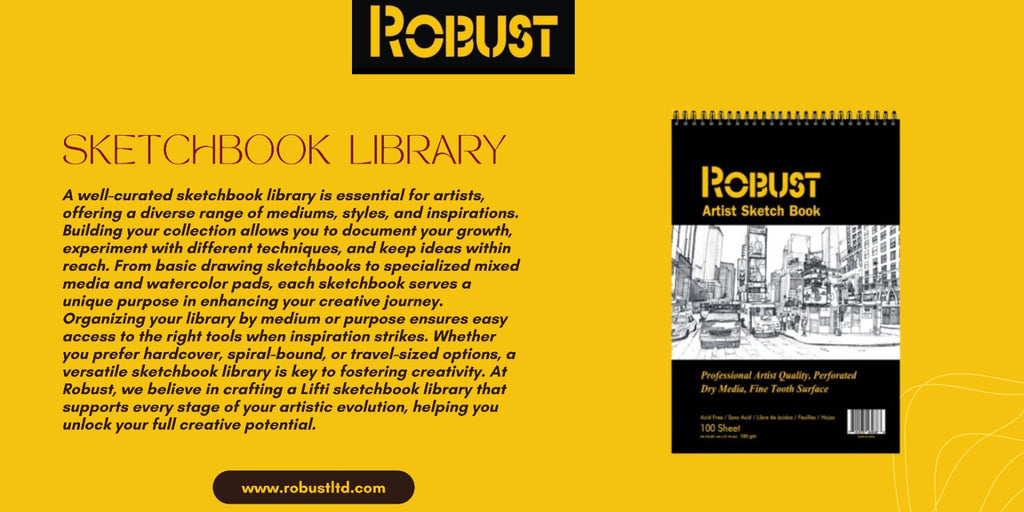
Building -Your- Sketchbook- Library- Essential Tips -and Must-Have -Collections

A well-curated sketchbook library is essential for artists, designers, and creatives of all levels. It serves as both a source of inspiration and a practical resource for enhancing your artistic skills. At Robust, we believe that building a versatile and diverse sketchbook collection is the cornerstone of artistic growth. In this guide, we’ll discuss how to build your sketchbook library effectively, highlight the must-have types of sketchbooks library, and offer practical tips for organizing and maximizing your collection.
Why You Need a Sketchbook Library
A sketchbook library offers a wealth of advantages. First, it helps you track your progress over time. By revisiting older sketchbooks, you can see how your style and techniques have evolved. Second, having a diverse range of sketchbooks allows you to experiment with different mediums and approaches. Whether you’re working with graphite, ink, watercolor, or mixed media, your sketchbook library can accommodate your artistic journey.
Another key reason to develop a sketchbook library is that it provides a quick reference for ideas, techniques, and inspiration. Rather than scouring through digital files, you can simply flip through your physical sketchbooks to reignite your creativity.
The Essential Types of Sketchbooks for Your Library
To build a comprehensive sketchbook library, it’s important to include various types of sketchbooks that cater to different styles, mediums, and projects. Here are some essential sketchbook types to consider:
1. Basic Drawing Sketchbook
A standard drawing sketchbook is a staple in any sketchbook library. These sketchbooks feature smooth paper that works well with pencils, charcoal, and ink. They’re ideal for quick sketches, detailed drawings, and concept development. Having a few different sizes in your collection ensures you’re prepared for on-the-go sketching as well as more elaborate works.
2. Mixed Media Sketchbook
Mixed media sketchbooks are designed to handle multiple mediums, from watercolor and acrylics to ink and colored pencils. Their thicker pages are durable enough for layering and adding texture, making them a versatile addition to your sketchbook library. A mixed media sketchbook is perfect for artists who like to experiment and combine techniques.
3. Watercolor Sketchbook
For artists who frequently work with watercolors, a dedicated watercolor sketchbook is a must-have. The textured, heavy-weight paper can absorb water without warping, giving you better control over your washes and details. Adding a few of these specialized sketchbooks to your sketchbook library can significantly elevate your painting practice.
4. Hardcover and Spiral-Bound Sketchbooks
The choice between hardcover and spiral-bound sketchbooks often comes down to personal preference. Hardcover sketchbooks offer durability and a professional look, while spiral-bound options allow for easy page flipping and removal. Including both in your sketchbook library ensures you have options for various projects and settings.
5. Travel and Pocket Sketchbooks
When inspiration strikes on the go, having a travel-sized sketchbook handy is invaluable. Pocket sketchbooks fit easily into your bag or pocket, making them perfect for capturing ideas while traveling, commuting, or simply exploring outdoors. Incorporating travel sketchbooks into your sketchbook library helps keep your creativity flowing no matter where you are.
6. Specialty Paper Sketchbooks
For those who enjoy working with specific mediums like pastels, markers, or calligraphy pens, specialty paper sketchbooks are a must. These sketchbooks feature unique paper textures or weights designed to enhance the performance of particular materials. By including specialty paper sketchbooks in your sketchbook library, you ensure you’re always prepared to create your best work with the right tools.
Tips for Organizing Your Sketchbook Library
An organized sketchbook library allows you to easily locate specific works, track progress, and revisit past ideas. Here are some practical tips for organizing your collection:
1. Label Your Sketchbooks
One effective way to organize your sketchbook library is by labeling each sketchbook with the dates and themes covered. This makes it easy to identify specific periods of your work or find a sketchbook dedicated to a particular project.
2. Sort by Medium or Purpose
Consider categorizing your sketchbook library by the medium or purpose of each sketchbook. For example, you could separate your sketchbooks into categories like “Watercolor,” “Figure Drawing,” or “Concept Development.” This approach streamlines your creative process by giving you quick access to the tools you need.
3. Create a Display
If you have space, consider displaying part of your sketchbook library in your studio or workspace. A neatly arranged shelf of sketchbooks not only serves as a source of inspiration but also adds an artistic touch to your environment. You can rotate which sketchbooks are on display to keep your space fresh and engaging.
4. Digital Cataloging
While physical sketchbooks are irreplaceable, creating a digital catalog of your sketchbook library offers additional convenience. You can photograph each page and organize the images into digital folders based on themes or dates. This way, you can quickly browse your sketches even when you’re away from your physical collection.
5. Preserve Your Sketchbooks
Preserving the condition of your sketchbooks is essential, especially if you want to revisit them years down the line. Store your sketchbook library in a cool, dry place away from direct sunlight. Using protective covers or cases can help prevent wear and tear over time.
Building a Lifti Sketchbook Library: A Creative Journey
Creating a Lifti sketchbook library isn’t just about accumulating sketchbooks; it’s about curating a collection that supports your creative journey. At Robust, we recommend being intentional with your selections. Start by identifying the types of sketchbooks that align with your artistic goals and gradually expand your collection.
Your Lifti sketchbook library should reflect your growth as an artist. Include sketchbooks that challenge you, encourage experimentation, and allow you to document your artistic evolution. Over time, your Lifti sketchbook library will become a treasure trove of ideas, techniques, and personal expression.
Conclusion
Building a sketchbook library is an enriching process that enhances your artistic practice and serves as a valuable creative resource. By carefully selecting and organizing your sketchbooks, you create an environment where inspiration and creativity thrive. At Robust, we encourage you to embrace the diversity and versatility that a well-curated sketchbook library offers. Whether you’re just starting out or are a seasoned artist, investing in a comprehensive sketchbook collection is a step toward unlocking your full creative potential.
From basic drawing sketchbooks to specialized watercolor pads, each addition to your sketchbook library plays a role in your artistic journey. So, start building, experimenting, and most importantly, enjoy the process of creating your very own Lifti sketchbook library!




